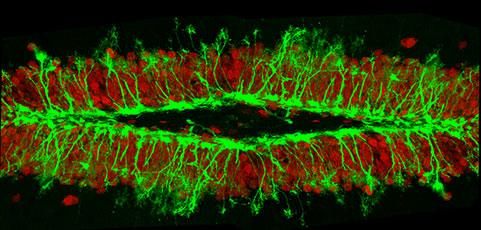Topics
Lunatic Fringe plays a key role in renewing neurons
The brain has a remarkable ability to generate new neurons in the hippocampus, the center of learning and memory, throughout our lifespan. The rate of neurogenesis (formation of new neurons) is affected by many factors, both internal and external. For e.g. physical activity and enriched environment enhance it, while loneliness and depression dampen it. Remarkably, about 700 new neurons are integrated into neural circuitry each day in the human center for learning and memory, but their numbers decline with age. Decreased neurogenesis has been associated with age-related cognitive decline and psychiatric disorders, such as anxiety and depression. Thus, adult hippocampal neurogenesis has garnered significant interest because targeting it could be a novel potential therapeutic strategy for many disorders.

Adult neurogenesis occurs through a sequential cascade of cell types, which starts with primary neural stem cells (NSCs) dividing asymmetrically to produce secondary progenitor cells called the amplifying neuroprogenitors (ANPs), which then mature into neuroblasts (NBs) and eventually into fully differentiated granule cells i.e. mature neurons. NSCs are essential for adult neurogenesis – without them, this phenomenon cannot take place. However, the NSCs pool is finite and the space NSCs inhabit together with their descendants is restricted. How is the fate of this complex community of cells regulated? What mechanisms preserve NSCs so that they can form new neurons throughout life while also ensuring optimal number of neurons? To understand how NSCs are precisely regulated, it is crucial to study them in isolation from their progeny, which had not been possible so far. Now, researchers at the Baylor College of Medicine and Jan and Dan Duncan Neurological Research Institute at Texas Children’s Hospital have developed a novel Lunatic fringe (Lfng) reporter and lineage tracing mouse model that selectively labels primary NSCs. Using these mice, researchers have found a novel mechanism by which descendants of NSCs are able to send feedback signals to alter the division and the fate of the mother cell. These findings have been published in the latest edition of the journal eLife.
“Our initial goal for this study was to find a gene that leads to selective expression in primary NSCs. Based on the information obtained from publicly available expression databases, we started with roughly 750 potential candidate genes. It took enormous amount of hard work and meticulousness to systematically narrow it down to a single gene – it was like looking for a needle in the haystack. After extensive analysis, we were convinced that Lunatic fringe, a member of the well-studied Notch signaling pathway, was the selective marker of NSCs,” said Mirjana Maletic-Savatic, M.D. Ph.D., assistant professor in the departments of Pediatrics and Neurology at Baylor and Texas Children’s Hospital, who led this study.
Previous studies in many vertebrate and invertebrate models have shown that Notch signaling pathway participates in the regulation of stem cell fate. However, the precise mechanism and the fine-tuning of Notch signaling in the adult hippocampal neurogenic niche have remained elusive until now.
Interestingly, NSCs and their progeny physically cluster closely around one another, which makes it an ideal environment for direct cell-cell communication between Notch receptor-bearing NSCs and membrane-bound ligands on the adjacent secondary progenitors (Jagged) or neurons (Delta).
This study by Maletic-Savatic and colleagues shows that Lunatic fringe helps NSCs to distinguish between Delta-expressing neurons and Jagged-expressing secondary progenitor cells (aka ANPs). It modifies the Notch receptor by glycosylation i.e. addition of carbohydrate molecules, so that the modified receptor responds to ligands differently than the native Notch receptor. Lunatic fringe-mediated glycosylation amplifies Delta-Notch signaling but dampens Jagged-Notch signaling.
When surrounded by Delta-expressing neurons, most neural stem cells remain in a stand-by mode protected from random activation and unnecessary division. On the other hand, when NSCs have already been activated to divide, they produce secondary progenitors (ANPs), which upon maturation express Jagged1 that can bind to the modified Notch receptor to eventually slow down Notch signaling in the NSC, leading to its eventual exit from the cell cycle. This allows division of every NSC to be finely regulated to prevent excessive division and premature exhaustion of its potential.
“This study and the mouse model we have generated is a huge step forward in the field of neural stem cell biology because now we not only have a benchmark to specifically label primary NSCs but have identified a key quality control step that determines their fate,” said Fatih Semerci, postdoctoral fellow in the Maletic-Savatic lab and the lead author of this study. "Lunatic fringe allows neural stem cells to decide whether to stay dormant or to divide, and once they start to divide, whether to continue or stop."
This study has far-reaching implications on the field of neurogenesis because age-related mental decline and psychiatric disorders such as anxiety and depression have been associated with a reduced ability to generate new neurons in the hippocampus, the center of learning and memory. The formation of neurons is affected by many factors, both internal and external. This study provides critical foundational knowledge needed to further understand and manipulate how natural biological process (e.g. aging), behavioral stimuli (e.g. physical exercise) and disease conditions (e.g. epileptic seizures) affect the formation and maintenance of adult-born neurons.




